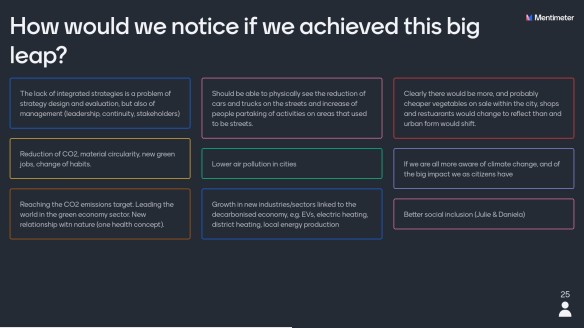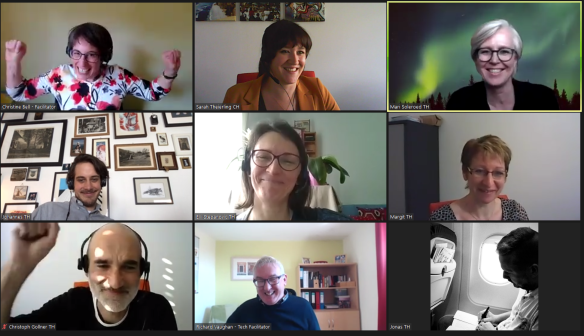Over the last month we have facilitated conferences for 40- 70 people that were planned as face to face event pre Covid19. In March 2020 we agreed with our clients that we would all take the risk and attempt to convert these planned events into virtual events. We were excited and a little nervous about taking this step but the option to postpone would mean that our clients would not be able to consult with their communities and this would hold up the planned strategy for 2020. We all agreed that it felt worth taking the risk and giving virtual events a go as “something would be better than nothing”.
Feedback Matters
It was a huge relief that the feedback from the events has been overwhelming postive. People have been surprised about how much was achieved and how engaging the virtual environment could be.
“You’ve set a new standard in terms of virtual workshops”
“It was an awesome interaction. For me I benefited hugely and I look forward to future engagements”
“A really impressive event, I’m still thinking through many of the observations and learning points I took from it.”
Learning Insights
In March 2020 we were experienced at facilitating virtual meetings for small groups of people, usually for planning purposes, we had experimented with digital tools within face to face events and we had completed some training in virtual facilitation. Scaling up the process and finding ways of bringing to the virtual world the warmth, friendship and engagement that we generate in face to face collaborations would be a challenge, and we were excited (and a bit scared) about how to make this happen. Here are some learning insights we have picked up on the way that are helping us to raise the game for virtual collaboration, to make it both possible but also enjoyable.
- Keep it Simple
In our first event we were keen to capture data from people at every stage and we were guilty of overcomplicating things. We have learnt that initially having breakout groups with no more than about 5 people and providing a simple conversation structure is enough. Keeping it dialogue only allows people the chance to meet, to engage with each other, to get used to being together virtually, without the barrier of another technological tool to get used to.
2. Provide Support and Structure
The virtual space still feel awkward for many people and the usual cues that start and end conversations are not as evident. We have found that having a table host helps to smooth this process. The table host can help the group to focus on the question, can bring people into the conversation and keep an overall awareness of time.
The table hosts have been from our team of trained virtual facilitators or subject experts provided by the client. All table hosts need to be competent and confident in using the technology and so training and support for them in their role is critical. Time and resources for this has to be factored in.
3. Make Digital Tools feel Familiar
Our events have been collaborative consultations and our clients needed to capture information and share that information between people. We have been using Mural as our preferred interactive tool. The advantages of Mural is that the interface is relatively intuitive to use and people can view and edit without having to set up an account.
We have set up the Murals to look like a typical group flipchart space with piles of post it notes and arrows and some easy to follow instructions.

4. Sharing Feedback
In large scale events it is always a challenge to share information across groups. In our virtual space we have swapped groups around so that people can view and add to the flipchart Murals created by previous groups. We have provided space for groups to report back briefly verbally so that they can share their main highlights and we have used a shared polling tool like Mentimeter as a way of groups sharing insights across the groups.

5. Screen Breaks
The common complaint about virtual events is the concentration which feel more intense than in a face to face event. We have learnt to build in regular screen breaks and to give people permission to turn off their video whilst we take a reflective pause. The moderator will turn off their video to cement this permission giving and then will turn their video back on with 1 minute to go and gently ask people to turn their videos on again when they are ready.
We Need to Talk about Money
This is awkward for everyone at the moment, to be very honest most facilitators are glad of any work right now so it was great to be able to invoice something. The reality is that we are a business and going forward we need to make a living from facilitating events or our businesses simply will not exist. The cost issue also applies to internal facilitators and organizers
These large scale events were planned and contracted for before they went virtual. We agreed to deliver them for the same price as the face to face events. I think we all recognize that this is not sustainable as a business. The costs for these types of complex virtual events are DIFFERENT but not cheaper than a face to face event. These are not events where you simply have someone speaking at the group with a bit of text chat. These events involve complex participatory dialogue and are designed to develop collaborative communities.
There are huge savings from the hire of a venue, the food for the event, the travel expenses, the overnight accommodation and all the glossy event materials. Our team saved time by not needed to pack and travel to the venues. But any savings on physical costs will be spent on the preparation time for the organizing team. The planning has to be much more precise than in the face to face world, everything needs to be created and uploaded in advance. You cannot just whip out a flipchart and a few post-it notes. To make a process be really engaging you have to meticulously plan the process, test the process and ensure that everyone involves knows exactly what they are doing and when. You have to communicate more and engage participants before the event and post event.
As a rough estimate I reckon our team spent 4-5 times longer working on the design and planning of the virtual events as we would have spent in a face to face event. With experience, practice and the value of being able to use existing templates this time will reduce but it is probably higher than we and our clients initially expected and as a business this is something that we have to seriously consider and discuss with our clients when we are providing cost estimates for events.
Would we do it again?
We have loved the challenge of working virtually. It was great to find ways of making the virtual tools work for larger groups and to find ways of creating events that combine on line and “offline” contact and connection.
There are huge benefits to the virtual format. We are facing a global climate emergency, and we have to reduce the amount of travel and the waste that is generated at events – there was no wasted food or surplus plastic at these events!
We recognize that virtual events enable people to participate who cannot travel easily to events, particularly those people with disabilities, caring responsibilities or who live in remote places with inadequate transport links. This can create much more diverse, inclusive consultation processes.
Virtual events offer a way to collaborate in a more intimate close up manner than is possible in physical settings at the moment. Given the choice of a virtual event or a “living with COVID-19” face to face event… we believe that virtual events will make it easier to collaborate than sitting 2 metres apart, wearing face coverings and not sharing any materials.
The more we facilitate virtually the better we can make the process and this period of experimentation gives us the opportunity to really develop the work and to find a way of making virtual events a viable option beyond the current restrictions on social interaction.
Next Steps and More Learning
We are moving into the next phase of virtual experimentation with our next events being planned from the start as virtual events and supporting people to use theory of change in collaborations, to develop new networks and form collaborative teams.
If you would like to be part of this experiment in virtual collaboration then do get in touch to talk about ways in which you can continue to collaborate, consult and engage with others whilst living in the Covid reality.


You must be logged in to post a comment.